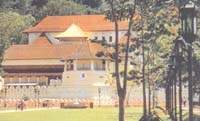| Gaveshaka
discusses the daily ritual at the Dalada Maligawa From ancient days the Tooth Relic was considered the symbol of authority to rule the country. Anyone who had possession of the Tooth Relic was accepted as the rightful person to be king. The kings therefore protected the Tooth Relic with maximum security. They either kept the Relic in the palace itself or built a special Temple of the Tooth in the palace premises. The king was very possessive of the Tooth Relic. He would not allow the public to see it. It was only at the annual festival that the public got a chance of seeing and venerating the Tooth Relic. According to historical records, the Tooth Relic was brought to Sri Lanka in 312 B.C during the reign of King Kit Siri Mevan. It was brought from Dantapura in Kalinga in India hidden in the hair of an Indian princess by the name of Hemamala, to protect it from being destroyed. (A beautiful painting in the Kelaniya Raja Maha Vihara done by the famous artist Soliyas Mendis depicts the event of bringing the Tooth Relic). King Kit Siri Mevan who was ruling from Anuradhapura, received the Tooth Relic with honour and kept it in a shrine within the royal palace. On the king’s orders, the Tooth Relic was brought out once a year and taken in procession to the Abhayagiri Vihara and exhibited to the people. Historical records also indicate how, whenever there was civil war in the country or when there was a threat from foreign powers, the Tooth Relic was taken away and hidden in a secure place either on a rock or in a remote temple where it could not be found. During peaceful times, the kings protected it and venerated it. The rituals observed today have come down from the days of the kings of Kandy, the last kingdom of the Sinhalese. The king personally conducted these and paid respects to the Tooth Relic. The alms were given by him and the practice of preparing 32 curries every day stems from the fact that the king was served with 32 curries and he offered part of the food to the Tooth Relic. Today the average devotees are able to offer alms according to a carefully prepared list given by the Dalada Maligawa officials. The alms are prepared in a special kitchen at the Maligawa and the devotees are expected to hand over the dry rations early so that the trained staff could prepare the alms in exactly the same way it has been done over the years. Since preparing such a large number of curries takes time, preparations are made from the previous day. Even ‘kevum’ is prepared every day. After the British took over the Kandyan Kingdom, they handed over the custody of the Tooth Relic to the two Maha Nayaka Theras of the Malwatte and Asgiriya temples, the leading Buddhist temples in Kandy, and the Diyawadana Nilame, the lay custodian. Two monks are resident in the Maligawa to conduct the rituals. Every year on the full moon day in the month of Esala (July), one temple (either Malwatte or Asgiriya) takes over the function of holding the rituals. The respective Maha Nayaka Thera would then select two senior monks to be in charge of the rituals thereafter for one year till the other temple takes over. The daily ritual is known as the ‘tevava’. This take place three times a daily in the morning, noon and evening. The beating of drums marks the beginning of the ‘tevava’ - the first of which starts as early as 5.15 in the morning. The two monks come down and having washed their feet, walk up to the ‘uda male’, the upper floor where the Sri Dalada is kept. A torch bearer walks in front followed by the ‘vattorurala’ who carries the keys. In the relic chamber, the monks light the lamps and make ready the utensils needed for the morning ritual which is a re-enactment of what a living Buddha would do like washing the face, cleaning the teeth, wearing the robe and taking a meal. The vessels carrying water and other utensils are made of gold. ‘Gathas’ (stanzas) are recited while conducting the ceremony and drumming continues in the ground floor. After offering of flowers, arrangements are made to offer the morning alms. Gold and silver bowls are used to serve the alms. Similar rituals
take place in the noon and evening with slight variations. The ‘daval
dane’ offered at mid day is an elaborate event. Devotees wait
in their numbers to take part in the ritual. They can offer flowers
in the inner chamber during a specified time limit when the doors
are kept open. |
||||
Copyright © 2001 Wijeya Newspapers
Ltd. All rights reserved. |
 While
the Esala Perahera is an annual event, elaborate rituals are followed
daily in honour of the Sri Dalada or the Scared Tooth Relic of the
Buddha. These take place at the Sri Dalada Maligawa in Kandy following
customs and traditions dating back to the time of the Sinhalese
kings.
While
the Esala Perahera is an annual event, elaborate rituals are followed
daily in honour of the Sri Dalada or the Scared Tooth Relic of the
Buddha. These take place at the Sri Dalada Maligawa in Kandy following
customs and traditions dating back to the time of the Sinhalese
kings.